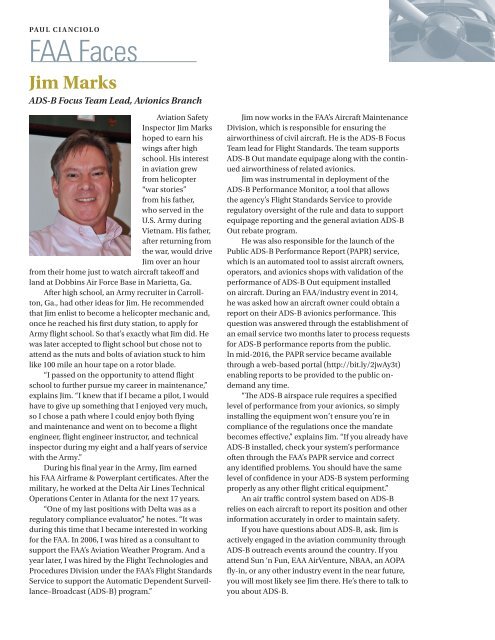Safety ADS-B
MarApr2017
MarApr2017
You also want an ePaper? Increase the reach of your titles
YUMPU automatically turns print PDFs into web optimized ePapers that Google loves.
PAUL CIANCIOLO<br />
FAA Faces<br />
Jim Marks<br />
<strong>ADS</strong>-B Focus Team Lead, Avionics Branch<br />
Aviation <strong>Safety</strong><br />
Inspector Jim Marks<br />
hoped to earn his<br />
wings after high<br />
school. His interest<br />
in aviation grew<br />
from helicopter<br />
“war stories”<br />
from his father,<br />
who served in the<br />
U.S. Army during<br />
Vietnam. His father,<br />
after returning from<br />
the war, would drive<br />
Jim over an hour<br />
from their home just to watch aircraft takeoff and<br />
land at Dobbins Air Force Base in Marietta, Ga.<br />
After high school, an Army recruiter in Carrollton,<br />
Ga., had other ideas for Jim. He recommended<br />
that Jim enlist to become a helicopter mechanic and,<br />
once he reached his first duty station, to apply for<br />
Army flight school. So that’s exactly what Jim did. He<br />
was later accepted to flight school but chose not to<br />
attend as the nuts and bolts of aviation stuck to him<br />
like 100 mile an hour tape on a rotor blade.<br />
“I passed on the opportunity to attend flight<br />
school to further pursue my career in maintenance,”<br />
explains Jim. “I knew that if I became a pilot, I would<br />
have to give up something that I enjoyed very much,<br />
so I chose a path where I could enjoy both flying<br />
and maintenance and went on to become a flight<br />
engineer, flight engineer instructor, and technical<br />
inspector during my eight and a half years of service<br />
with the Army.”<br />
During his final year in the Army, Jim earned<br />
his FAA Airframe & Powerplant certificates. After the<br />
military, he worked at the Delta Air Lines Technical<br />
Operations Center in Atlanta for the next 17 years.<br />
“One of my last positions with Delta was as a<br />
regulatory compliance evaluator,” he notes. “It was<br />
during this time that I became interested in working<br />
for the FAA. In 2006, I was hired as a consultant to<br />
support the FAA’s Aviation Weather Program. And a<br />
year later, I was hired by the Flight Technologies and<br />
Procedures Division under the FAA’s Flight Standards<br />
Service to support the Automatic Dependent Surveillance–Broadcast<br />
(<strong>ADS</strong>-B) program.”<br />
Jim now works in the FAA’s Aircraft Maintenance<br />
Division, which is responsible for ensuring the<br />
airworthiness of civil aircraft. He is the <strong>ADS</strong>-B Focus<br />
Team lead for Flight Standards. The team supports<br />
<strong>ADS</strong>-B Out mandate equipage along with the continued<br />
airworthiness of related avionics.<br />
Jim was instrumental in deployment of the<br />
<strong>ADS</strong>-B Performance Monitor, a tool that allows<br />
the agency’s Flight Standards Service to provide<br />
regulatory oversight of the rule and data to support<br />
equipage reporting and the general aviation <strong>ADS</strong>-B<br />
Out rebate program.<br />
He was also responsible for the launch of the<br />
Public <strong>ADS</strong>-B Performance Report (PAPR) service,<br />
which is an automated tool to assist aircraft owners,<br />
operators, and avionics shops with validation of the<br />
performance of <strong>ADS</strong>-B Out equipment installed<br />
on aircraft. During an FAA/industry event in 2014,<br />
he was asked how an aircraft owner could obtain a<br />
report on their <strong>ADS</strong>-B avionics performance. This<br />
question was answered through the establishment of<br />
an email service two months later to process requests<br />
for <strong>ADS</strong>-B performance reports from the public.<br />
In mid-2016, the PAPR service became available<br />
through a web-based portal (http://bit.ly/2jwAy3t)<br />
enabling reports to be provided to the public ondemand<br />
any time.<br />
“The <strong>ADS</strong>-B airspace rule requires a specified<br />
level of performance from your avionics, so simply<br />
installing the equipment won’t ensure you’re in<br />
compliance of the regulations once the mandate<br />
becomes effective,” explains Jim. “If you already have<br />
<strong>ADS</strong>-B installed, check your system’s performance<br />
often through the FAA’s PAPR service and correct<br />
any identified problems. You should have the same<br />
level of confidence in your <strong>ADS</strong>-B system performing<br />
properly as any other flight critical equipment.”<br />
An air traffic control system based on <strong>ADS</strong>-B<br />
relies on each aircraft to report its position and other<br />
information accurately in order to maintain safety.<br />
If you have questions about <strong>ADS</strong>-B, ask. Jim is<br />
actively engaged in the aviation community through<br />
<strong>ADS</strong>-B outreach events around the country. If you<br />
attend Sun ‘n Fun, EAA AirVenture, NBAA, an AOPA<br />
fly-in, or any other industry event in the near future,<br />
you will most likely see Jim there. He’s there to talk to<br />
you about <strong>ADS</strong>-B.



